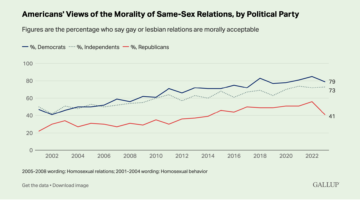Study: Gay Men are Shorter on Average Compared to Straight Men
February 18, 2016 by Justin Lehmiller

In recent years, scientists have found that sexual orientation is related to a wide range of physical features. Among other things, studies have reported that sexual orientation is linked to facial symmetry, finger length ratios (specifically, the length of the second digit compared to the fourth digit), as well as which hand is dominant. A new study published in the Journal of Sex Research suggests that height is one additional physical feature we should add to this growing list, at least for men.
In this study, researchers analyzed the data of 863 Canadian adults (415 men; 447 women) who were recruited for a study of sexuality and physical development. Approximately half of the participants came from college campuses, whereas the other half were recruited at off-campus locations (e.g., at LGBT pride events) in an attempt to obtain more sexual diversity. Participants were 26 years old on average, and most were White and had completed at least some college. Just about half of the sample was gay or bisexual, while the other half was heterosexual.
In addition to collecting information on participants’ sexuality, researchers obtained two measures of height: a self-report measure and an objective measure, in which height was determined by a research assistant.
The results revealed that both men and women overstated their height on the self-report measure compared to the objective one, which provides evidence for the importance of collecting objective data in studies of this nature.
How did height relate to sexual orientation? When looking at the self-report measure, there was no association with sexuality. However, when looking at the objective measure, there was—but only for men.
Specifically, heterosexual men were significantly taller than gay men. To put this in perspective, the difference in average height was a little over 2 centimeters (about 0.8 inches).
Bisexual men did not differ in height compared to either gay or heterosexual men. In addition, there were no differences in objective height between lesbian, bisexual, and heterosexual women.
I should note that in the analyses mentioned above, researchers statistically controlled for age, ethnicity, education level, recruitment location, and whether participants were compensated for taking part in the study in an attempt to rule these out as possible alternative explanations for any differences observed.
So what might account for the height difference between gay and straight men? The researchers argue that it’s consistent with other research and theory suggesting that prenatal hormone exposure affects adult sexual orientation. The basic idea is that when male fetuses are exposed to different hormone levels (e.g., lower testosterone), this has effects on the brain that create a predisposition to homosexuality; at the same time, this also generates a number of physical changes (e.g., effects on height).
As for why the difference in height was only observed for men, we cannot say for sure; however, scientists believe that sexual orientation may develop differently in men and women (i.e., there may be different mechanisms at play), so that could explain why the height effect was specific to men.
That said, there are some important limitations of this research. For one thing, the sample was not representative, and the gay and heterosexual participants were largely recruited from different venues (most gay participants were from LGBT pride events, while most heterosexual participants were from college campuses). In addition, we cannot infer cause-and-effect from these data or pinpoint the source(s) of the observed differences in height among men.
It’s also important to highlight that, while this study found a height difference on average, it’s definitely not the case that all heterosexual men are taller than all gay men. There is a lot of individual variability, so you cannot just look at a man’s height and infer his sexuality based on that alone.
I should also mention that although there are some very tall gay men out there, this doesn’t necessarily invalidate the prenatal hormone theory because many researchers believe that there isn’t a single cause for a given sexual orientation. There may be multiple paths. This means, for example, that two people could be gay, but they could have very different physical features and the underlying factors contributing to their sexuality could be very different.
More research is needed, especially studies looking at the link between objective height and sexuality in more representative samples; however, these results are consistent with several other studies in pointing to a likely biological basis for the development of sexual orientation.
Want to learn more about Sex and Psychology? Click here for more from the blog or here to listen to the podcast. Follow Sex and Psychology on Facebook, Twitter (@JustinLehmiller), or Reddit to receive updates. You can also follow Dr. Lehmiller on YouTube and Instagram.
To learn more about this research, see: Skorska, M. N., & Bogaert, A. F. (2016). Sexual orientation, objective height, and self-reported height. The Journal of Sex Research.
Image Source: 123rf/Rafael Ben-Ari
You Might Also Like:

Dr. Justin Lehmiller
Founder & Owner of Sex and PsychologyDr. Justin Lehmiller is a social psychologist and Research Fellow at The Kinsey Institute. He runs the Sex and Psychology blog and podcast and is author of the popular book Tell Me What You Want. Dr. Lehmiller is an award-winning educator, and a prolific researcher who has published more than 50 academic works.
Read full bio >

